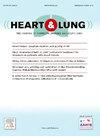Assessment of COVID-19 incidence after performing pulmonary function tests during the pandemic: Findings from a real-life cohort
IF 2.4
4区 医学
Q2 CARDIAC & CARDIOVASCULAR SYSTEMS
引用次数: 0
Abstract
Background
Pulmonary function testing (PFT) is paramount in assessing patients with respiratory symptoms and chronic cardiopulmonary diseases. Although seminal studies have demonstrated that PFT generates aerosols, this simple observation does not confirm the potential for enhanced pathogen transmission.
Objective
We aimed to describe the frequency of patients who developed suspected symptoms of COVID-19, prompting SARS-CoV-2 testing after undergoing PFT during the reopening of a laboratory amid the deceleration of the pandemic.
Methods
We analyzed a retrospective cohort of individuals referred for PFT between May and August 2021. Two weeks post-PFT, phone calls were made asking about suspected symptoms of COVID-19, leading to SARS-CoV-2 testing. The medical data of the participants who did not answer the phone calls were reviewed through institutional electronic records. The minimum sample size of 338 individuals was calculated to detect an incidence of COVID-19 at least ten times higher than the surrounding local rate (0.08 %).
Results
Three hundred and sixty patients (40.6 % men; 56.5 ± 17.6 years) were included. PFT was primarily indicated for functional and prognostic assessments of chronic respiratory diseases. Three hundred and sixteen patients answered the follow-up phone calls. Following PFT, most patients (357/360) did not report suspected symptoms leading to COVID-19 confirmation testing. Three patients underwent RT-PCR testing, which yielded negative results.
Conclusion
Patients in this real-life cohort, after performing PFT, did not experience an outbreak (with a rate of at least ten times the surrounding local rate) or a cluster (with two or more cases) of symptomatic COVID-19.
在大流行期间进行肺功能检查后评估COVID-19发病率:来自现实生活队列的发现。
背景:肺功能测试(PFT)在评估呼吸道症状和慢性心肺疾病患者中至关重要。虽然开创性的研究已经证明PFT产生气溶胶,但这一简单的观察结果并不能证实可能会增强病原体的传播。目的:我们旨在描述在大流行减速期间重新开放实验室期间进行PFT后出现COVID-19疑似症状的患者的频率,这些患者在接受PFT后促使进行SARS-CoV-2检测。方法:我们分析了2021年5月至8月间转介的PFT患者的回顾性队列。pft后两周,他们打电话询问COVID-19的疑似症状,从而进行了SARS-CoV-2检测。没有接听电话的参与者的医疗数据通过机构电子记录进行审查。计算最小样本量为338人,以检测到COVID-19的发病率至少比周围当地发病率(0.08%)高10倍。结果:360例患者(男性40.6%;56.5±17.6岁)。PFT主要用于慢性呼吸系统疾病的功能和预后评估。316名患者接听了随访电话。在PFT之后,大多数患者(357/360)没有报告导致COVID-19确诊检测的疑似症状。3例患者接受了RT-PCR检测,结果均为阴性。结论:该现实队列患者在实施PFT后,未出现COVID-19症状性暴发(发生率至少为周围当地发生率的10倍)或聚集性暴发(有两个或更多病例)。
本文章由计算机程序翻译,如有差异,请以英文原文为准。
求助全文
约1分钟内获得全文
求助全文
来源期刊

Heart & Lung
医学-呼吸系统
CiteScore
4.60
自引率
3.60%
发文量
184
审稿时长
35 days
期刊介绍:
Heart & Lung: The Journal of Cardiopulmonary and Acute Care, the official publication of The American Association of Heart Failure Nurses, presents original, peer-reviewed articles on techniques, advances, investigations, and observations related to the care of patients with acute and critical illness and patients with chronic cardiac or pulmonary disorders.
The Journal''s acute care articles focus on the care of hospitalized patients, including those in the critical and acute care settings. Because most patients who are hospitalized in acute and critical care settings have chronic conditions, we are also interested in the chronically critically ill, the care of patients with chronic cardiopulmonary disorders, their rehabilitation, and disease prevention. The Journal''s heart failure articles focus on all aspects of the care of patients with this condition. Manuscripts that are relevant to populations across the human lifespan are welcome.
 求助内容:
求助内容: 应助结果提醒方式:
应助结果提醒方式:


